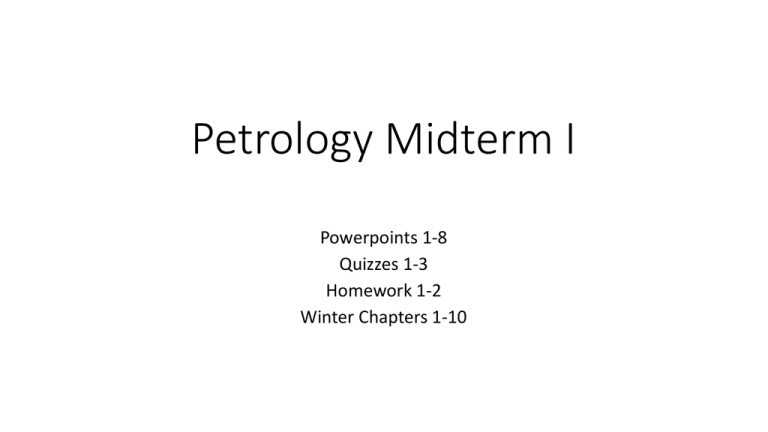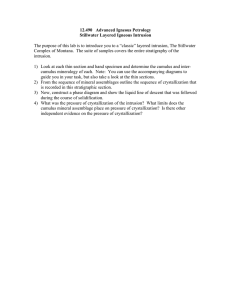Petrology Midterm I Powerpoints 1-8 Quizzes 1-3 Homework 1-2
advertisement

Petrology Midterm I Powerpoints 1-8 Quizzes 1-3 Homework 1-2 Winter Chapters 1-10 1) Introduction to Igneous Petrology and Earth’s Physical and Chemical Structure • Milestones to an understanding of igneous processes • Chemical and Physical Structure of the Earth • Heat Sources, heat transfer mechanisms and geothermal gradients • Relationships of mantle dynamics and plate tectonics 2) Classification of Igneous Rocks • Goals of a classification scheme • Essential minerals to ultramafic, mafic and felsic modal classification schemes • Normalization of modes for a ternary diagram • Other modifiers for a complete description of an igneous rock • Significance of bulk rock textures in gabbros – ophitic vs. intergranular • The good and the bad of modal classification schemes • Utility of cumulate classification schemes • Chemical classification of volcanic • Classifications of volcaniclastic rocks 3) Physical Igneous Petrology • Physical and chemical properties of 4 main classes of lavas • Contrast in eruptive character of basalts vs. intermed/felsic lavas • Distinguishing subaerial from submarine basalt eruptions • 3 types of pyroclastic deposits • Intrusion shape types • Styles and mechanisms of magma emplacement at different crustal depths 4) Introduction to Thermodynamics • What is Thermodynamics? • 3 states of energy – unstable, metastable, stable • What is Gibbs Free Energy and why is pertinent to igneous systems? • What are the main variables controlling G? • What are intrinsic vs. extrinsic variables • Reference state conditions for measuring G • Understand why melting curves in P-T space have a positive slope (related to P-V and T-S relationships) 5) One- and Two-Component Phase Diagrams • Empirical and experimental evidence on how magmas crystallize • Basic parameters of Phase Diagrams (P, T, X) • Gibbs Phase Rule and determining the degrees of freedom on phase diagrams • One-component systems – Qtz, H2O • Two-component systems with Solid Solution – An-Ab, Fo-Fa • Two-component systems with a Eutectic – Di-An • Two-component systems with a Peritectic – Fo(-En)-Qtz (extra credit) • The lever rule in determining the % of liquid and solid during equilibrium crystallization • Understand how processes of melting and crystallization can be portrayed on binary phase diagrams. 6) Multi-component Phase Diagrams An-Fo-Di ternary system • Understand how equilibrium melting and crystallization are portrayed • Understand how the lever rule is used to determine the proportion and compositions of solid phases and the liquid • Understand the rocks formed due to equilibrium crystallization vs. fractional crystallization 7) Major, Minor and Trace Element Chemistry • General major, minor, and trace element constituents of a basalt • General compositional differences between mafic and felsic magmas • What CIPW norms are used for • X-Y Harker diagrams – indicators of magmatic differentiation in magmatic series • AFM diagrams – discriminate what? • Difference between HFSE and LIL trace elements • Concept of trace element compatibility and definition of mineralliquid partition coefficients • Behavior of REE during partial melting and fractional crystallization 8) Mantle Melting and the Generation of Basaltic Magma • Lherzolitic composition of the mantle • Variation in the aluminous phase with depth – Pl – Sp – Gt • Geothermal gradients compared to mantle melting curves • 3 ways to get the mantle to melt – increase T, adiabatic decompression, increased volatiles. • 5 ways to create compositional diversity among mafic magmas






